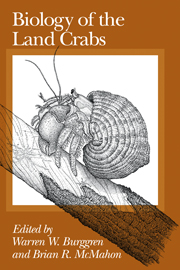Book contents
- Frontmatter
- Contents
- List of contributors
- Preface
- 1 BIOLOGY OF THE LAND CRABS: AN INTRODUCTION
- 2 EVOLUTION, SYSTEMATICS, AND GEOGRAPHICAL DISTRIBUTION
- 3 ECOLOGY
- 4 BEHAVIOR
- 5 REPRODUCTION AND DEVELOPMENT
- 6 GROWTH AND MOLTING
- 7 ION AND WATER BALANCE
- 8 RESPIRATION
- 9 CIRCULATION
- 10 ENERGETICS AND LOCOMOTION
- 11 EPILOGUE
- APPENDIX: Natural histories of selected terrestrial crabs
- References
- Author index
- Systematic index
- Subject index
1 - BIOLOGY OF THE LAND CRABS: AN INTRODUCTION
Published online by Cambridge University Press: 04 August 2010
- Frontmatter
- Contents
- List of contributors
- Preface
- 1 BIOLOGY OF THE LAND CRABS: AN INTRODUCTION
- 2 EVOLUTION, SYSTEMATICS, AND GEOGRAPHICAL DISTRIBUTION
- 3 ECOLOGY
- 4 BEHAVIOR
- 5 REPRODUCTION AND DEVELOPMENT
- 6 GROWTH AND MOLTING
- 7 ION AND WATER BALANCE
- 8 RESPIRATION
- 9 CIRCULATION
- 10 ENERGETICS AND LOCOMOTION
- 11 EPILOGUE
- APPENDIX: Natural histories of selected terrestrial crabs
- References
- Author index
- Systematic index
- Subject index
Summary
Why study land crabs?
The Decapoda represent a highly diverse and successful crustacean order, with over 8, 500 described species. Although the great majority of decapods are strictly aquatic, inhabiting either marine or freshwater habitats, some of the most fascinating (and certainly most readily observable) of the decapods are those that have become adapted in varying degrees to life on land. Various aspects of the biology of land crabs have been treated in a number of reviews and research articles (for examples see reviews by Bliss, 1968; Powers and Bliss, 1983), but to date there has been no systematic attempt to assemble the available material into a single, cohesive account. Thus, the purpose of this book is to provide a broadly based, yet unified, presentation of the biology of the land crabs.
Biologists have been documenting species and describing the natural history, morphology, and ecology of the semiterrestrial and terrestrial crabs for more than a century. Yet, the scientific interest in these decapods has burgeoned in recent years. For example, of the approximately 1, 000 references that have been cited in this book, more than 40% have been published just in the last decade. How can we account for this recently expanding interest in land crabs?
First, those decapods adapted for life on land present fascinating case studies in many different disciplines. For example, the ecologist is presented with an unusual situation in many tropical islands, where the top of the energy pyramid may be occupied not by a vertebrate but rather by a land crab. The physiologist encounters a very complex arrangement where gas exchange may be achieved simultaneously by “lungs, ” gills, and other body surfaces rather than just by gills.
- Type
- Chapter
- Information
- Biology of the Land Crabs , pp. 1 - 5Publisher: Cambridge University PressPrint publication year: 1988
- 6
- Cited by

